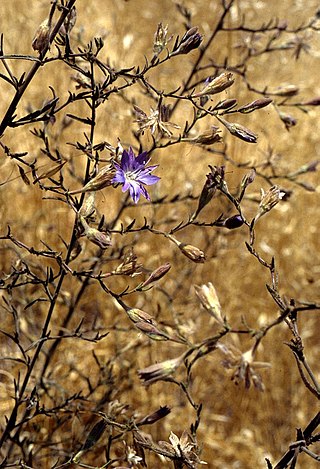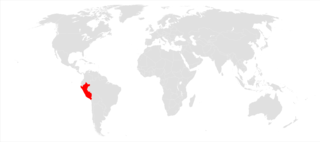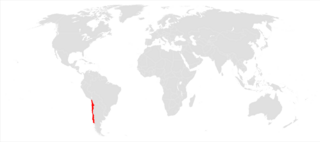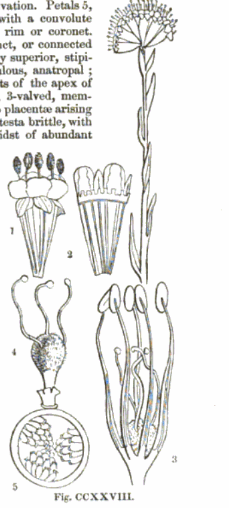
Malesherbia is a genus of flowering plants consisting of 25 species in the Passifloraceae. This is a xerophytic group endemic to the Peruvian and Chilean deserts and adjacent Argentina. The genus is currently recognized by the APG III system of classification in the family Passifloraceae, and is the sole member of the subfamily Malesherbioideae.
Dubouzetia is a genus of about eleven species known to science, growing from shrubs up to large trees, in Papuasia and Australasia and constituting part of the plant family Elaeocarpaceae.

Malesherbia angustisecta is an endangered member of Malesherbia (Passifloraceae). It is colloquially called clavelina. The first published description of the species dates to 1922 and Hermann Harms is accredited with its discovery. It is native to arid and semiarid deserts of Peru. It is a pale green woody shrub and has pale pink / white flowers.

Malesherbia ardens, a member of Malesherbia (Passifloraceae), is a shrub with red flowers, native to the arid deserts of Southern Peru, though it can be found in the northern regions of the country. It is colloquially called Lampaya. The oldest known record of M. ardens dates 1927 in the 4th volume of the Field Columbian Museums' Botanical series. James Francis Macbride is accredited with its discovery.

Malesherbia arequipensis is a herbaceous member of Malesherbia (Passifloraceae) with white flowers. It first described in 1961 by botanist Mario H. Ricardi Salinas and is native to Arequipa and Moquegua. It is the only member of Malesherbia that grows outside of the Andes. It grows up to 15 cm tall and has white flowers.

Malesherbia auristipulata is a perennial woody shrub in the genus Malesherbia (Passifloraceae). Locally it is called Ají de Zorra. M. auristipulata is commonly found in Northern Chili and rarely in Tacna, Peru. In general, the species range is very restricted as a result M. auristipulata is considered a rare plant. It is likely that there are less than 100 individuals left, classifying the species as critically endangered by the local government.

Malesherbia corallina, a member of Malesherbia (Passifloraceae), is a subshrub native to the deserts and dry shrubland of Tarapacá Chile. It was originally identified in 2003 by Mélica Muñoz-Schick and Pinto, and is considered very rare with less than 20 plants documented.

Malesherbia densiflora is a perennial herb native to the Andean foothills in Atacama Chile. M. densiflora can grow up to 40 cm tall and has white racemose flowers.

Malesherbia deserticola is a subshrub native to the deserts and dry shrublands of Antofagasta and Atacama Chile. It can reach heights of 40 cm and has white racemose flowers.

Malesherbia fasciculata is a subshrub that is native to the subtropics of Northern and Central Chile. The flowers of M. fasciculata are white with red sepals, dark purple anthers, and are globular in shape.

Malesherbia humilis is an annual herb that grows in the subtropics of northern and central Chile to Argentina.
Malesherbia lactea is a perennial geophyte native to the La Rioja and San Juan regions of Argentina and the Antofagasta and Atacama regions of Chile. It has ovate leaves that end in a sharp point. Similar to other members of Malesherbia, the flowers are red and white, and tubular in shape.

Malesherbia linearifolia is a subshrub native to the Coquimbo, Valparaiso, Metropolitana, and O'Higgins regions of Chile. It was the first member of Malesherbia to be described, with the original description dating to 1797 by Cavanilles.
Malesherbia lirana is a perennial herb whose native range is from Argentina and Chile. The species has racemose inflorescences that are 2 - 3.9 cm in size and cream colored petals. It flowers in spring to late summer.

Malesherbia paniculata is perennial subshrub native to the Atacama, Coquimbo, Valparaíso, Metropolitana, and O'Higgins regions of Chile. It can be found at elevations of up to 2600m to sea level. It was originally described in 1827 by D. Don.
Malesherbia scarlatiflora is a shrub native to the pacific slopes of Peru. It grows up to 1 meter tall, has narrow ovate-acuminate leaves, and orange flowers.
Malesherbia solanoides is a subshrub native to the Atacama region of Chile. It was initially described in 1833 by Reise Erde.
Malesherbia splendens is a subshrub native to the Lurín river basin of the Andean region of Peru. It is found at altitudes of 2100-3000m. It can grow up to 1 meter tall and has yellow/green flowers. It has low genetic diversity, potentially due to its small species range. It is currently classified as endangered due to low genetic diversity and diminishing species boundary due to the expansion of goat farming.
Malesherbia tocopillana is a subshrub native to Tocopilla, Antofagasta Chile. It is found in costal deserts at altitudes of 150 - 400 m. It reaches heights of 50 cm, has 25 - 65mm long leaves and simple racemes pink flowers. It is considered a very rare plant, with only 9 live individuals documented, as such, it is classified as endangered.
Malesherbia weberbaueri is a subshrub native to Apurímac, Ayacucho, Huancavelica and Junín. It is found at altitudes of 2300-3600 meters.








